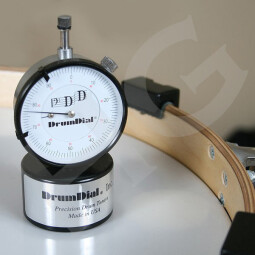Tuning a drum kit is in itself an art, which many drummers don't really master. It's no wonder then that many professional drummers rely on specialists for the task, especially for recording sessions. And it's true that properly tuning drums requires a lot of experience, just like tuning a piano. In this article we'll try to give you some basic universal rules that will allow you to enter more confidently into the world of harmonics...
Keep cool!
Good tuning requires patience and concentration, especially if your kit has 12 drums. Before attempting anything else, you need to make sure that you will be able to work in a comfortable position. If you don’t have the right posture or you are on your knees on a tiled floor, you’ll tend to lose your concentration during the process and will end up rushing some moves. So let’s start by making ourselves comfortable!
Using a table is very practical because you can put the drums on the table to work standing up and walk around them. However, it’s always better to be able turn the drum, for which you can use a rotating drum throne. If you choose this option, you can sit down right in front of it to get quick access to all lugs by turning the drum throne.
A comfortable drum key with an ergonomically designed wing nut is very important as well, so that you don’t end up with sore fingers after only three turns!
The fundamental frequency of the drum
Once you have found the right position, you can start opening your ears to discover the natural sound of the drum to be tuned. Good quality drums always produce a rather distinctive note when you hit the shell. Some drum kits are even put together based around this particular note, making it easier to get a consistent tuning for the full kit. If this isn’t your case, don’t worry, hit each shell all the same so that you can get an idea of the resonance frequency of the wood. In fact, the most common tuning technique is to tune the heads to the same frequency of the shell to give the drum more resonance and loudness.
First head…
Let’s start with the resonant head first, that is, the head on the bottom that you don’t hit but resonates nicely with the batter (or top) head. After making sure that the bevel edges of the shell are perfectly smooth (in extreme cases, you might want to consider sanding them slightly…), place the head and the drum hoop, centering them as best as you can, and tighten the lugs using only the force of your fingers. Whenever you start feeling some tension, push slightly on the head to loosen it up and get an even tension all around.
When you can’t tighten the lugs anymore with your bare hand, grab your drum key and keep on tightening the head diagonally, which means tightening a lug and the lug right opposite to it, then tightening the lug next to the latter, and so on. Some drum techs prefer to skip one lug, especially on large shells.
Now, turn the key just halfway and up to three full turns on large shells or if you want the heads to be very tight, for a snare drum, for example. While you are at it, check the frequency of the shell constantly and try to tune the head accordingly.
When you think you’ve got it, hit the head on each lug to check if the note is the same all around the head border. The tension on the head must be even, which means you’ll need to adjust each lug slightly with the drum key.
You can also verify the drum hoop on the shell edge: the height must be the same all around the drum. If it isn’t uniform, it means that you did something wrong or that the drum hoop has lost its shape!
Batter head
Once you’re done with the resonant head, proceed the same way with the batter head. You can tune this head slightly higher than the resonant one in order to get a bend effect: the attack will have a higher pitch than the sustain, creating a nice, warm and sexy “Ooouum.”
For the snare drum, set the pitch and check its consistency around the head while keeping the strainer off the resonant head.
For the kick, use a bass drum batter to check the tension during the tuning process. Also check for any ripples close to the drum hoop. You can press the head with your hand to loosen it up.
Now it’s your turn…
This method is simple and provides you with an optimal and classic drum sound. Depending on your needs and your drum kit, we recommend you to try out less standard tuning methods to discover your own tuning secrets.
Do note that several manufacturers offer special keys equipped with a system to tighten all lugs evenly. And you can also find even more precise products to measure the tension on the head. Even if such systems don’t guarantee a musical tuning, they allow you to tune your drums much quicker and with a basic tuning that you can manually fine tune later.
And now, it’s your turn to find the perfect pitch!



